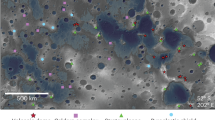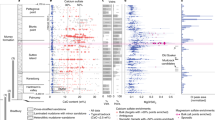Abstract
Rocks dominated by the silicate minerals quartz and feldspar are abundant in Earth’s upper continental crust1. Yet felsic rocks have not been widely identified on Mars2, a planet that seems to lack plate tectonics and the associated magmatic processes that can produce evolved siliceous melts on Earth3. If Mars once had a feldspar-rich crust that crystallized from an early magma ocean such as that on the Moon, erosion, sedimentation and volcanism have erased any clear surface evidence for widespread felsic materials. Here we report near-infrared spectral evidence from the Compact Reconnaissance Imaging Spectrometer for Mars onboard the Mars Reconnaissance Orbiter for felsic rocks in three geographically disparate locations on Mars. Spectral characteristics resemble those of feldspar-rich lunar anorthosites4,5, but are accompanied by secondary alteration products (clay minerals). Thermodynamic phase equilibrium calculations demonstrate that fractional crystallization of magma compositionally similar to volcanic flows near one of the detection sites can yield residual melts with compositions consistent with our observations. In addition to an origin by significant magma evolution, the presence of felsic materials could also be explained by feldspar enrichment by fluvial weathering processes. Our finding of felsic materials in several locations on Mars suggests that similar observations by the Curiosity rover in Gale crater6 may be more widely applicable across the planet.
This is a preview of subscription content, access via your institution
Access options
Subscribe to this journal
Receive 12 print issues and online access
$259.00 per year
only $21.58 per issue
Buy this article
- Purchase on Springer Link
- Instant access to full article PDF
Prices may be subject to local taxes which are calculated during checkout




Similar content being viewed by others
References
Winter, J. D. Principles of Igneous and Metamorphic Petrology (Prentice Hall, 2010).
McSween, H. Y. Jr, Taylor, G. J. & Wyatt, M. B. Elemental composition of the Martian crust. Science 324, 736–739 (2009).
Carr, M. H. & Head, J. W. III Geologic history of Mars. Earth Planet. Sci. Lett. 294, 185–203 (2010).
Ohtake, M. et al. The global distribution of pure anorthosite on the Moon. Nature 461, 236–240 (2009).
Cheek, L. C., Donaldson Hanna, K. L., Pieters, C. M., Head, J. W. & Whitten, J. L. The distribution and purity of anorthosite across the Orientale basin: New perspectives from Moon Mineralogy Mapper data. J. Geophys. Res. 118, 1805–1820 (2013).
Meslin, P-Y. et al. Soil diversity and hydration as observed by ChemCam at Gale crater, Mars. Science 341, 1238670 (2013).
Elkins-Tanton, L. T. Magma oceans in the inner solar system. Annu. Rev. Earth Planet. Sci. 40, 113–139 (2012).
Mustard, J. F. et al. The surface of Syrtis Major: Composition of the volcanic substrate and mixing with altered dust and soil. J. Geophys. Res. 98, 3387–3400 (1993).
Bandfield, J. L., Hamilton, V. E. & Christensen, P. R. A global view of Martian surface compositions from MGS-TES. Science 287, 1626–1630 (2000).
Wyatt, M. B. & McSween, H. Y. Jr. Spectral evidence for weathered basalt as an alternative to andesite in the northern lowlands of Mars. Nature 417, 263–266 (2002).
McLennan, S. M. Sedimentary silica on Mars. Geology 31, 315–318 (2003).
Horgan, B. & Bell, J. F. III. Widespread weathered glass on the surface of Mars. Geology 40, 391–394 (2012).
Foley, C. N., Economou, T. & Clayton, R. N. Final chemical results from the Mars Pathfinder alpha proton X-ray spectrometer. J. Geophys. Res. 108, 8096 (2003).
Bandfield, J. L., Hamilton, V. E., Christensen, P. R. & McSween, H. Y. Jr. Identification of quartzofeldspathic materials on Mars. J. Geophys. Res. 109, E10009 (2004).
Ehlmann, B. L. et al. Identification of hydrated silicate minerals on Mars using MRO-CRISM: Geologic context near Nili Fossae and implications for aqueous alteration. J. Geophys. Res. 114, E00D08 (2009).
Smith, M. R. & Bandfield, J. L. Geology of quartz and hydrated silica-bearing deposits near Antoniadi crater, Mars. J. Geophys. Res. 117, E06007 (2012).
Christensen, P. R. et al. Evidence for magmatic evolution and diversity on Mars from infrared observations. Nature 436, 504–509 (2005).
Carter, J. & Poulet, F. Ancient plutonic processes on Mars inferred from the detection of possible anorthositic terrains. Nature Geosci.http://dx.doi.org/10.1038/ngeo1995 (2013).
Rogers, A. D., Aharonson, O. & Bandfield, J. L. Geologic context of in situ rocky exposures in Mare Serpentis, Mars: Implications for crust and regolith evolution in the cratered highlands. Icarus 200, 446–462 (2009).
Edwards, C. S., Bandfield, J. L., Christensen, P. R. & Fergason, R. L. Global distribution of bedrock exposures on Mars using THEMIS high-resolution thermal inertia. J. Geophys. Res. 114, E11001 (2009).
Adams, J. B. & Goullaud, L. H. Plagioclase feldspars: Visible and near infrared diffuse reflectance spectra as applied to remote sensing. Proc. Lunar Planet. Sci. Conf. 9, 2901–2909 (1978).
Serventi, G. et al. Spectral variability of plagioclase-mafic mixtures (1): Effects of chemistry and modal abundance in reflectance spectra of rocks and mineral mixtures. Icarus 226, 282–298 (2013).
Popa, C., Esposito, F. & Colangeli, L. New landing site proposal for Mars Science Laboratory (MSL) in Xanthe Terra. 41st Lunar Planet. Sci. Conf. abstract 1807 (2010).
Irwin, R. P. III., Wray, J. J., Maxwell, T. A., Mest, S. C. & Hansen, S. T. 3rd Int. Conf. on Early Mars abstract 7066 (Lunar and Planetary Institute, 2012).
Christensen, P. R. et al. Morphology and composition of the surface of Mars: Mars Odyssey THEMIS results. Science 300, 2056–2061 (2003).
Gunnarsson, B., Marsh, B. D. & Taylor, H. P. Jr. Generation of Icelandic rhyolites: Silicic lavas from the Torfajokull central volcano. J. Volcanol. Geotherm. Res. 83, 1–45 (1998).
Robbins, S. J., Di Achille, G. & Hynek, B. M. The volcanic history of Mars: High-resolution crater-based studies of the calderas of 20 volcanoes. Icarus 211, 1179–1203 (2011).
Hiesinger, H. & Head, J. W. III The Syrtis Major volcanic province, Mars: Synthesis from Mars Global Surveyor data. J. Geophys. Res. 109, E01004 (2004).
Hurowitz, J. A. et al. In situ and experimental evidence for acidic weathering of rocks and soils on Mars. J. Geophys. Res. 111, E02S19 (2009).
Hausrath, E. M., Navarre-Sitchler, A. K., Sak, P. B., Steefel, C. I. & Brantley, S. L. Basalt weathering rates on Earth and the duration of liquid water on the plains of Gusev crater, Mars. Geology 36, 67–70 (2008).
Acknowledgements
Portions of this work were supported by NASA Mars Data Analysis Program grant NNX13AH80G. We thank B. Horgan for a review and H. McSween, J. Mustard, B. Ehlmann, R. Clark and C. Viviano for discussions.
Author information
Authors and Affiliations
Contributions
J.J.W. carried out the spectral analysis, wrote most of the text and assembled the figures, with assistance from S.T.H. Thermodynamic equilibria models and related text were contributed by J.D. G.A.S. carried out laboratory spectral analyses. S.L.M. and F.P.S. produced the CRISM data products. J.R.S., R.P.I. and M.S.G. provided input on the text.
Corresponding author
Ethics declarations
Competing interests
The authors declare no competing financial interests.
Supplementary information
Supplementary Information
Supplementary Information (PDF 609 kb)
Rights and permissions
About this article
Cite this article
Wray, J., Hansen, S., Dufek, J. et al. Prolonged magmatic activity on Mars inferred from the detection of felsic rocks. Nature Geosci 6, 1013–1017 (2013). https://doi.org/10.1038/ngeo1994
Received:
Accepted:
Published:
Issue Date:
DOI: https://doi.org/10.1038/ngeo1994
This article is cited by
-
Volcanism in the Solar System
Science China Earth Sciences (2023)
-
Effects of Water Saturation on the Dynamic Compression and Fragmentation Response of Gabbroic Rock
Rock Mechanics and Rock Engineering (2022)
-
Effects of Test Temperature and Low Temperature Thermal Cycling on the Dynamic Tensile Strength of Granitic Rocks
Rock Mechanics and Rock Engineering (2021)
-
Polymorphism of feldspars above 10 GPa
Nature Communications (2020)
-
On Granites
Journal of the Geological Society of India (2019)



